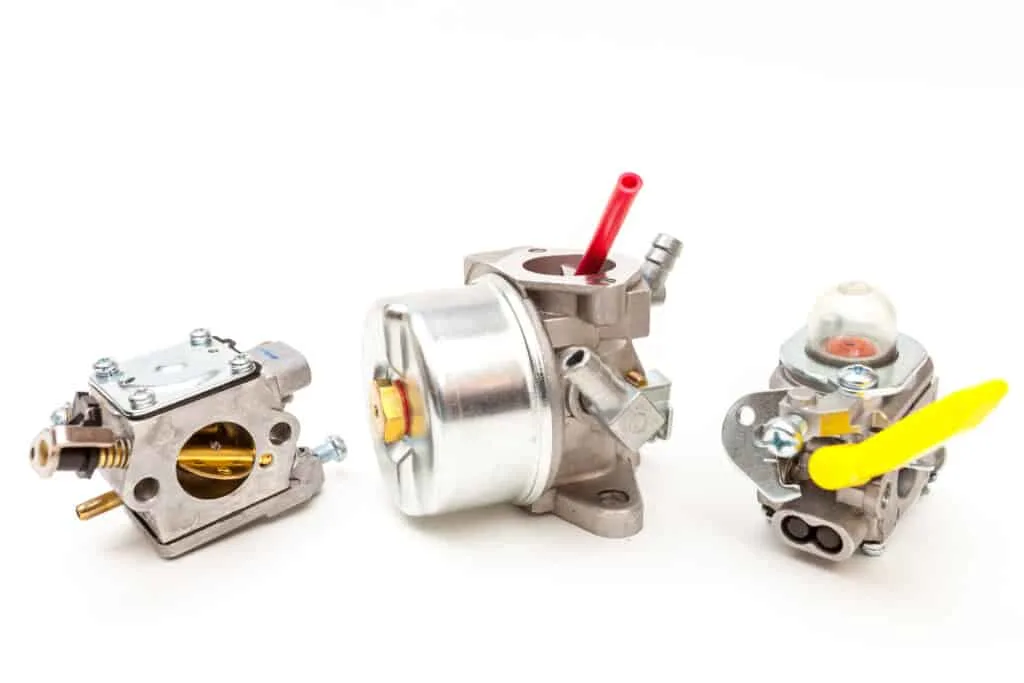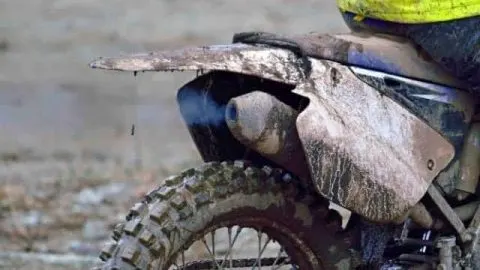Having a two-stroke backfiring can cause a lot of alarm, but it isn’t something that is usually too serious. However, it is still good to know why backfires happen and what to do if you want to fix the problem.
The most common cause for a two-stroke backfire is because of rapid deceleration of the mower. This allows too much air to enter the engine causing the revolution to be thrown off. Deceleration is not the only reason for a two-stroke mower to backfire.
It is also important to quickly cover what a backfire is. A backfire occurs can be internal combustion or a reaction with the fuel vapors outside the engine. Below, we’ll cover the other reasons a two-stroke mower can backfire, as well as covering how to make sure they don’t happen. We’ll also go into more depth about why rapid deceleration causes a backfire.
Two-Stroke Engines
There are both two-stroke and four-stroke engines. Both perform the same five actions: intake, compression, ignition, combustion, and exhaustion. Some problems can occur at any of these stages, which can lead to backfiring. A two-stroke engine performs these functions in two strokes of the piston. This constitutes one revolution. A four-stroke engine completes these functions in four strokes of the piston. A four-stroke engine completes these functions in two revolutions.
A crucial difference between the two-stroke and four-stroke engines is how the gasoline is mixed. A four-stroke engine has a place where you pour in the gasoline and a place where you pour in your oil. A two-stroke engine will have you mix your oil in with the gasoline that you are using.
Timing

While there are specific things that happen in an engine that leads to backfiring, they all boil down to timing. Timing is the key to allowing the engine to complete its revolutions smoothly. In breaking this process down, it is important to know how the engine works. For combustion to occur, there has to be an intake of oxygen. The combustion chamber has an intake and exhaustion vent.
Thus, air must first be drawn into the engine. If air is drawn in too quickly (as detailed in the next section), the timing is thrown off. Once there is oxygen in the combustion chamber, it is drawn into the cylinders of the engine. Inside the cylinder, you have your positions. These are what compresses the air. This builds up the pressure needed for a spark to be created from the interaction of oxygen and gasoline.
Obviously, once this spark has been created, it will combust creating the power needed for the engine to run. The excess energy will be drawn out through the exhaust system. This occurs over and over again allowing your engine to run. This is why timing is so important.
If there is a delay in any of these reactions, the others will continue. Without one of the reactions being fully completed, there is a build-up of wasted fuel which reacts with the air outside and combusts. This is how backfiring occurs; the offset of timing within the revolutions of the engine.
Rapid Deceleration
As stated above, rapid deceleration of the engine is the most common cause for a two-stroke engine to backfire. This is because the rapid deceleration draws in too much air. In order for combustion to take place, there has to be a certain amount of air present. However, when there is too much air, the ignition process is delayed.
Typically, when a spark is made in the engine, it ignites all of the fuel. This creates the mini-combustion that results in the power necessary to make the engine run. Too much air makes it impossible for the spark to light all of the fuel at the same time. Instead, it reacts with the fuel vapors in the chamber and ignites those. This is an example of a backfire caused by internal combustion.
Preventing this problem is pretty simple. You want to slowly decrease the engine speed of the mower. This gives the reactions enough time to react fully. If you have a mower that is run with a throttle, simply let it up slowly. With a two-stroke engine that uses a throttle, the most common problem is that there is not enough spring on the throttle cable. The springs can also get lost easily. These factors can all lead to a backfire.
Fuel Pumps and Air Filters
If your two-stroke is not starting or else backfiring a lot when it does, this could mean that your fuel pump is clogged or damaged. The fuel pump helps to keep the correct ratio of fuel and air in the engine. When your fuel pump is malfunctioning, there is typically too little fuel being pumped to the cylinders. The lack of fuel makes it difficult for the cylinders to fire properly. This usually means that your lawn mower won’t run very well.
When there is too much air being pumped into the system, this can also cause a two-stroke engine to backfire. The amount of air that is drawn in creates low-pressure fuel. Again, the ratio of air to fuel is unbalanced. This creates a similar scenario to the rapid deceleration of the engine. The sparks created in the cylinders and pistons react only with a portion of the fuel.
When your fuel pump is malfunctioning, you have two options: you can repair it or you can replace it. If you notice that your motor is not running as well and backfiring, it probably means that you need to take a look at your fuel pump.
Sometimes, when your two-stroke engine backfires, it can indicate that there is something wrong with the fuel pump and air filters. When an air filter is clogged it limits the amount of fresh air that can enter the engine. This causes problems with the entire ignition process in generating power for the engine.
Fortunately, this is an easy fix. Simply clean or replace the air filter and then your motor should run more smoothly. It is important to make sure that you are doing this regularly. Because the air filter is meant to keep out dirt and small rocks from damaging the engine, it can get clogged quickly.
Carburetors

Another problem area on a two-stroke that can cause it to backfire is the carburetor. The carburetor regulates the volume of air and gas that is needed for proper combustion to happen. When you have a mixture of air and gas that is too lean, the unburnt fuel builds up and ignites when the air from the exhaust comes out.
This is also a quick fix. You simply have to adjust the screws on the carburetor to allow for the right mix of fuel and air to mix. If you’re not sure about how much you need to adjust them, it is probably best to take your equipment to a local repair shop. They will be able to adjust the screws to the right settings.
If you decide to adjust the screws yourself, make sure that you don’t do drastic changes. You want to adjust them slowly and then see if your lawnmower backfires. If it is still backfiring, then adjust the screws a little more.
Problems with Gasoline
Interestingly, backfiring can happen because of the gasoline. Different types of engines require different mixes of fuel. If gasoline has too much ethanol in it, this makes it so the engine runs less efficiently. This is because high-ethanol content can corrode the metal that an engine is made of. Because of this, the life of your engine will decline. This can lead to more backfires because the engine is not performing all of the reactions it needs to properly.
There can also be problems if you have too much ethanol in with your gasoline. Most guidelines recommend that you have 10% ethanol alcohol added to the mix. When you get above 15% that is when corrosion of your carburetors and pistons can start to occur. This corrosion happens naturally because of the chemical makeup of ethanol.
It is also important that you get fuel that is manufactured for two-stroke engines. This will help to make sure that you are following the fuel recommendations for small engines. If you aren’t sure what those are, you need to look up the guidelines for your state. Each state will have similar guidelines, but specifics will vary based on your location. You can also check your user’s guide or contact your local mechanic.
Making sure that your fuel is clean and new is also important. Typically, fuel will stay good for up to 30 days. However, based on what type of climate you live in the gasoline can go bad more quickly. If you decide to mix your fuel, make sure that you are following the proper ratios.
For two-stroke engines, you want to have a 50:1 of gas and oil. You don’t want to mix oil with your gasoline for your four-stroke engine, because it is not built in the same way.
See also: Cleaning Gas Tank of Two-Stroke Engine.
Overheating
Another problem that causes a two-stroke engine to backfire is overheating. If you are running the engine at a speed that is higher than its normal engine temperatures, it will overheat. This added stress on the engine will create pressure, and when oxygen comes into contact with the fuel vapors backfiring will happen. This backfiring can also occur even if you have shut off your engine. However, this type of backfire is called an afterfire.
If you notice that the engine is going too fast to run properly, it is a good idea to slow down the engine. This gives it the time that it needs to go through the cycles of intake, compression, ignition, combustion, and exhaustion.
Even though these reactions happen quickly, the engine must be running at a speed where all can be completed properly. When the engine is going too fast, it can throw off the delicate balance of timing. It causes the processes to speed up and after a few revolutions, the efficiency declines. As it continues to decline, there is a higher chance of a backfire happening.
Cost of Repairs

So how much can these repairs cost? That is almost as important as having a machine that works. We’ll give a brief overview of how much it can cost to repair parts or to replace them. This will also cover what it will cost to go to a mechanic to get these parts replaced.
Carburetor: If you need to repair a carburetor and you take it to a mechanic, it can cost up to $200-$300. This will depend on the amount of damage that your carburetor has sustained. If you need a new carburetor, it can cost anywhere from $500-$800.
If you decide to try and fix it yourself, you’ll probably need a few new screws. It is also a great idea to watch some helpful DIY Youtube videos on how you can effectively fix your part. But, depending on the amount of damage that has happened, you might have to get a new one.
Air Filter and Fuel Pumps: Air and oil filters range from $10-$20 depending on the brand and quality you want to have. A fuel pump is relatively close in price to the air and oil filters. Fuel pumps range from $15 to-20. This is much easier to pay for. It will be a lot cheaper to also replace the part yourself rather than having a mechanic charge you for parts and manual labor.
Generally speaking, most of the issues that cause backfires will not cause your engine to fall apart if you don’t fix it. Most of the time, backfire is just caused by the timing of the revolution being off. So, if you don’t mind a loud bang now and then, it should be fine to continue mowing your lawn as usual. Obviously, it is important to get your motor fixed if it is causing a lot of major problems, or not working properly.

